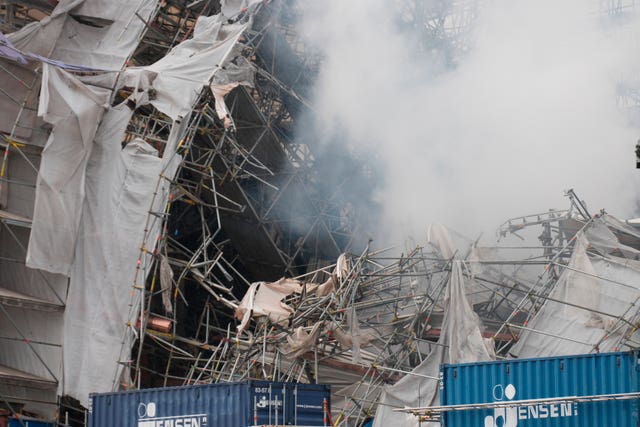
Firefighters stabilising the burned-out husk of Copenhagen’s historic Old Stock Exchange have tried to use giant shears on a crane to cut away dangling scaffolding, but suffered a setback when the implement fell into the debris.
A large blaze broke out on Tuesday at the 400-year-old landmark in Copenhagen, toppling its roof and famous dragon-tail spire, and on Thursday, a large section of the outer wall of the building collapsed inwards.
The most valuable paintings and items inside had been saved from the flames, and no one was injured.

“A further building collapse is absolutely a possibility,” said Tim Ole Simonsen, a spokesman for Greater Copenhagen Fire Department, adding that structural engineers were assessing how to remove precarious remnants of scaffolding. “It is very difficult work.”
He later said the work had been paused and “our efforts have taken a new turn”, after the powerful shears mounted on the end of a crane fell into the ruins of the building.
There were also small pockets of fire to extinguish and “tons” of debris to remove, he added.
Brian Mikkelsen, who heads the Danish Chamber of Commerce which owns the 1615 building and was headquartered there, said 45% of the structure had been saved, and he underlined pledges made earlier in the week to rebuild the structure.
“It will be rebuilt as it was,” Mr Mikkelsen said as Prime Minister Mette Frederiksen visited the site unexpectedly on Friday afternoon to thank the firefighters, saying their quick response on Tuesday was “impressive” and to give “huge, huge respect”.
She also supported the idea of rebuilding the Old Stock Exchange but said it was too early to say whether the government would take part in any financing.

“We need to get a better overview, like for instance the insurance money,” Ms Frederiksen said.
Tuesday’s blaze is believed to have started on the roof of the building, which had been wrapped in scaffolding while the building was being renovated. The cause remains unclear, and police have yet to enter the burned part of the building to investigate.
The plan to remove the scaffolding was an attempt to salvage the unharmed part of the Copenhagen landmark. Firefighters said they could not say how long that would take, and adjacent streets were still closed to traffic.
No decision has been made about who will finance a reconstruction, a project that would cost millions, if not billions and take years.
The exchange, known for its green copper roof and distinctive intertwined dragon tails, sits on the waterfront next to the Danish parliament. It is considered a leading example of the Dutch Renaissance architectural style in Denmark.
The Chamber of Commerce moved into the building after Copenhagen’s stock exchange left in 1974.


Comments: Our rules
We want our comments to be a lively and valuable part of our community - a place where readers can debate and engage with the most important local issues. The ability to comment on our stories is a privilege, not a right, however, and that privilege may be withdrawn if it is abused or misused.
Please report any comments that break our rules.
Read the rules here